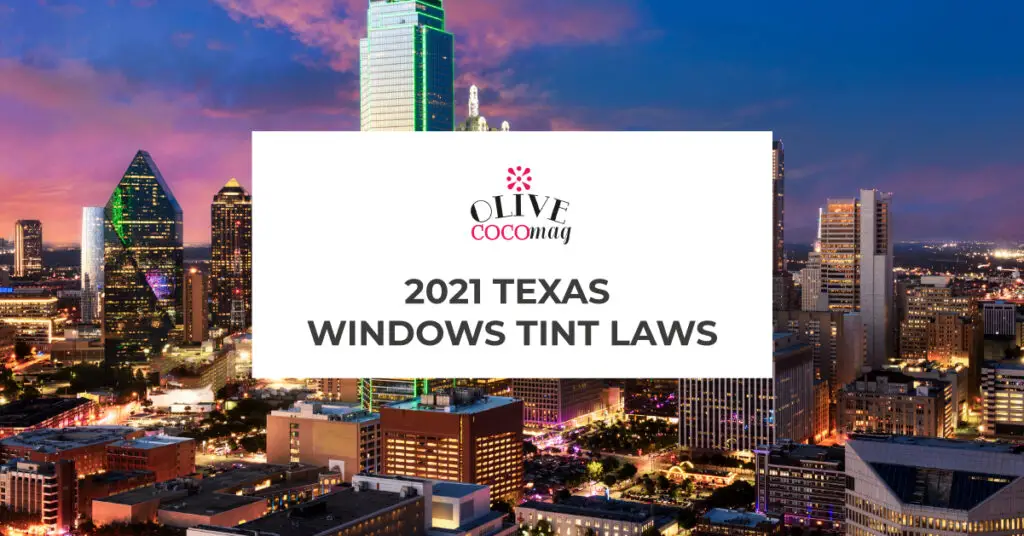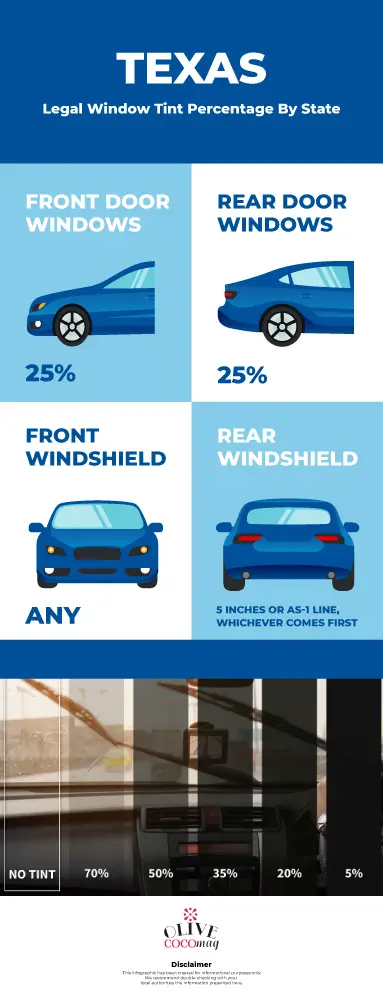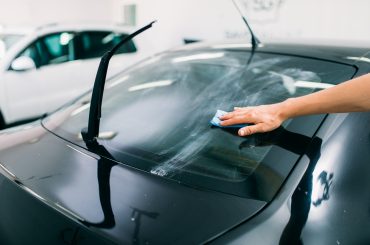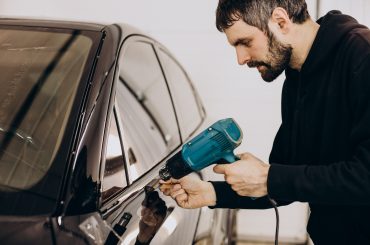Texas window tint laws are similar to most other states. But they are not the same and have differences. Texas tint laws are quite straightforward and clear. These laws are imposed due to various safety and security concerns. If the windows are too darkly tinted, it will cause the potential of accidents, especially at night. Usually, people would want to tint their car windows to get a better look and more protection from harmful UV radiation.

So, if people want to get their vehicles tinted, they can do so, by staying within the legal limitations of the state. There are laws enforced to regulate the darkness allowed on car window tints in Texas.
Table of Contents
Is it Legal to Have Tinted Windows in Texas?
Yes, vehicles in Texas are allowed to have window tint. Being a state with bright sunshine throughout the year, it is essential to have proper car window tints that would block off the harmful radiations and mitigate the damage. But the amount of tint allowed on your vehicles would vary depending on certain factors and considerations in Texas tint laws.
Tint Laws for Passenger Vehicles
In general, the Texas window tint law for passenger vehicles states that the value of the Visible Light Transmission (VLT %) factor should be at least 25% or more. More details on this are elaborated on below.
Texas Window Tint Laws

The first car window tinting law in Texas was enacted in 2009. The application of window tint laws has decided the amount of darkness allowed on automobiles, cars, vans, SUVs, and trucks. There are some vehicles that are exempted by the window tint requirements of Texas laws. These are; law enforcement vehicles, buses, taxis, and vehicles used under medical permits. There are also situations where people are allowed to have darker window tints based on their medical requirements. Let’s identify the main laws imposed by legal authorities of the state of Texas. It should be noted that the VLT values indicated below should be the combination of both the window glass and tint together. These values are not measured individually.
Tint darkness for sedans:
- Windshield: 25% VLT tint is allowed above the manufacturer’s AS-1 line or top 5 inches, with less than 25% reflection.
- Front Side windows: Must allow more than 25% of light in. Back Side windows: Any darkness can be used.
- Rear Window: Any darkness can be used with a side outside mirrors, 25% VLT without.
Tint darkness for SUV and vans:
- Windshield: 25% VLT tint is allowed above the manufacturer’s AS-1 line or top 5 inches, with less than 25% reflection.
- Front Side windows: Must allow more than 25% of light in.
- Back Side windows: Any darkness can be used.
- Rear Window: Any darkness can be used with a side outside mirrors, 25% VLT without.
Window Tint Reflection in Texas
Tint reflection for sedans:
- Front Side windows: Must not be more than 25% reflective.
- Back Side windows: Must not be more than 25% reflective.
Tint reflection for SUV and vans:
- Front Side windows: Must not be more than 25% reflective.
- Back Side windows: Must not be more than 25% reflective.
Legal Tint Limits for Multi-Purpose Vehicles in Texas
- Front Windshield: 25% VLT tint is allowed above the manufacturer’s AS-1 line or top 5 inches, with less than 25% reflection.
- Front-seat side windows: up to 25% tint darkness allowed
- Back seat side windows: Any tint darkness can be used
- Rear window: Any tint darkness can be used if you have side outside mirrors – 25% tint required without side mirrors
Front Windshield Tint Strip
It is not prohibited to tint your windshield visor in Texas. But there are certain restrictions. Windscreen tinting must be applied only above the AS-1 line. In case of the absence of an AS-1 line, the measurement is considered as up to 5 inches down from the top of the windshield. This AS-1 line parameter is derived from the fact that there are letters AS-1 indicated on most of the vehicles and located parallel to the top of the windshield.
Only the topmost 5 inches (known as the visor strip) can be tinted and should allow at least 25% VLT through it. This is applicable for the cars, vans, SUVs, and trucks in Texas. This rule is maintained so as to maintain the driver’s visibility while reducing the glare as possible. Nevertheless, the entire rear window, without any lines and barriers, can have a tint of 25% VLT or more if you have side-view mirrors installed.
Other Window Tint Rules and Regulations in Texas
The state of Texas has several other important laws, rules, and regulations with respect to window tinting. They consist of the following:
- Side Mirrors: If the vehicle’s rear window is tinted dual side mirrors are mandatory.
- Restricted Colors: Window tint colors red, blue, and amber are not allowed for use on the windshields by Texas tint laws.
- Certificates: it is necessary for film manufacturers to certify the films they sell within this state. Before you purchase, check with your dealer to confirm that they are using certified films.
- Stickers: There should be a sticker to identify legal tinting. It is required to have this sticker of certification between the film and glass on the window of the driver’s side.
- Medical Exceptions: The state of Texas allows medical exemptions for special window tint. To get more details about these specific terms of the exemption, consult Texas tint laws.
Cost of a Window Tint Ticket
This is the most frequently asked question among vehicle owners in Texas. Even though you are willing to follow the rules and abide by the laws correctly, it is always good to know everything. The fine would depend on the following:
- The level of darkness in your window tint than the legal limit.
- Your history of receiving window tint tickets and the number of tickets
- The fact that you have removed the window tint or not.
If you have not got pulled over before, and it is the first ticket you got, you would be advised to remove the tint and get a fine of around $20 to $25. If you haven’t followed the first advice and get a second tint, the fine would be around $275, including court costs. This fine would increase with the number of tickets you get.
It is always a good idea to follow the laws and tint your car windows within the legal limits of the state. To learn more about the alternative colors and shades that you can use, refer to our articles 10 Tips for Choosing Window Tint Colors and also Window Tint Shades Chart.
Window Tint Medical Exemptions
Medical exemptions for window tints are allowed in Texas. Motorists can find out the method of getting a medical exemption by contacting the state’s Department of Public Safety. The driver needs to provide a signed statement or prescription from a licensed physician, optometrist, or ophthalmologist. It should be stated that the relevant driver needs to be allowed tint law exemptions due to medical conditions, in order to safeguard their health. Even though a medical exemption is allowed, you would only be allowed to have the two front windows below 25% VLT, except the windshield. This should be approved by the Texas Department of Public Safety, Regulatory Services Division.
Is 5% Legal in Texas?
The answer is no. The minimum VLT allowed in Texas is 25%. You cannot go lower than that. Even 20% would be clearly illegal. Even the driers with eye problems and medical exemptions can have a minimum of 25%. You should understand that legal restrictions are enforced to secure public safety through the correct vision of drivers and to prevent illegal activities inside vehicles.
All laws and related explanations have been described above. But if you are looking for some Frequently Asked Questions where you would need quick and simple answers to clarify your doubts, refer to the FAQs below.
FAQs on Texas Window Tint Laws
- What is the darkest amount allowed for vehicle windows in Texas?
- A minimum of 25% is the legal VLT allowed for the front windows and windshield.
- Is 5% window tint illegal in Texas?
- Having 5% VLT for front windows or windshields is completely illegal in Texas.
- Is it legal to tint windshields in Texas?
- Yes, but VLT should be 25% or above.
- Is 20% window tint illegal in Texas?
- Yes, anything less than 25% VLT is illegal, unless you are allowed to have a medical exemption.
- What are the colors restricted for window tints in Texas?
- Red, blue and amber colors are banned from using as vehicle window tints
New Updates to Texas Tint Laws
A complete compilation of all the government laws on motor vehicles in the state of Texas can be obtained from the Texas DMV website online. You can also get a copy of the same by visiting a local office of the Department of Motor Vehicles.
State of Texas Information
Texas is the second-largest among the states in the United States of America. It is also the second most populous state. It is considered the largest state among the 48 contiguous United States. Its capital city is Austin. The geographical location is towards the Southern Central part of the country. Texas shares an international border with some Mexican states namely Chihuahua, Coahuila, Nuevo León, and Tamaulipas to the south. The U.S. state of New Mexico is on the west, Oklahoma in the north, Louisiana to the east, and Arkansas in the northeast.
It has an area of 268,820 square miles (696,200 square kilometers) and a population of 26.1 million people. The largest city in Texas is Houston and it is also the fourth largest in the United States. The second-largest city in Texas is San Antonio and it is the seventh-largest city in the United States. There are a total of 254 counties in Texas, which is the largest amount in any state.
For the rules, regulations, and laws of other states, please refer to the article on Window Tint Laws in the US by state.
Please refer to the following attachment on the constitutional laws of the Texas transportation code TRANSP § 547.613. Restriction on Windows.
*Keep in mind that Texas tint laws can change daily and may be interpreted differently in your city or county. To be sure, we recommend double-checking our information with your local DMV or Law Enforcement Authorities. Furthermore please let us know if there are any changes to make.








